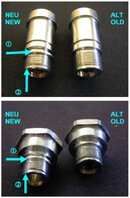I just finished the rebuild of the MK5 that I already had clean.... I also converted it to a DIN.
It seems to recover even faster than MK20/25

(less orings ?)
Just like the Mk20 the IP drops a bit after sitting for 15-20 mins.
A few years ago I did some experimenting to try to test the IP drop and recovery of MK2, MK5, MK10, MK15, and a MK20 with the composite piston. Conventional wisdom would imply that as the flow capacity of the reg increases (in the order I listed) the IP drop would lessen. I found that was not the case with a single 2nd stage and an IP gauge on the LP inflator hose. The MK15 seemed to dip the most, and the MK10 dipped substantially more than the MK2 or MK5, almost the opposite of what you'd expect. I even spoke at length with Peter Wolfinger about it; surprisingly, he had not answer and not much interest in it.....
Then I tried connecting 2 and even 3 balanced adjustables, all with very strong purges, and putting all of them under full purge simultaneously. That changed the results; the MK15 and 20 initially dropped quite a bit then recovered and stayed around 10 PSI under IP, while the other regs really dropped....at least 25 PSI. But all of them had a big initial drop and then some recovery under continuous purge.
So, my best guess is that the results are influenced by venturi effect in the LP chamber; the MK2 seems to have far less of this than do the others. That's probably due to the turret in which all the LP ports are connected on the other regs. IOW, fast flow out some of the ports to the 2nd stages causes a drop in pressure in the other ports, i.e. LP inflator hose. It would be good to get an inline IP gauge that could be installed right at the 2nd stage hose connection and see if the results are different; my guess is that they would be. What this implies is that the later SP balanced piston regs have an air path that results in greater venturi effect, and I wouldn't doubt that. Putting the LP inflator hose on the end LP port (where an occasional knucklehead will insist that you get "20% better breathing") made no difference on any of the regs.
Did you have a MK5 DIN retainer, and if so, where did you get it? It's different than the retainer for the others I believe. Awap has figured out some arrangement with steel washers that seems to work well.
I am not sure what exactly the slight drop in IP is after the reg sits pressurized, but my guess is that there is an initial seating force that slightly lowers as the piston/seat surface mate more fully. I notice this with all my MK5s and 10s. I wish it could be explained by something clever like cooling of the air in the IP path, but if anything, the air should warm up in there, so I don't know where that couple of PSI goes unless it leaks out someplace. There are lots of places it could do so, and we're only talking about a very small quantity of air. It's definitely nothing to worry about.





